NOTE: This blog has been updated as of May, 2025 to reflect what we have learned since we installed this system in June, 2022. Changes are noted in red.
After months of trying, we were finally able to get a Trane Heat Pump! Jimmy, Scott’s brother, is an HVAC guy and was able to get one for us wholesale.
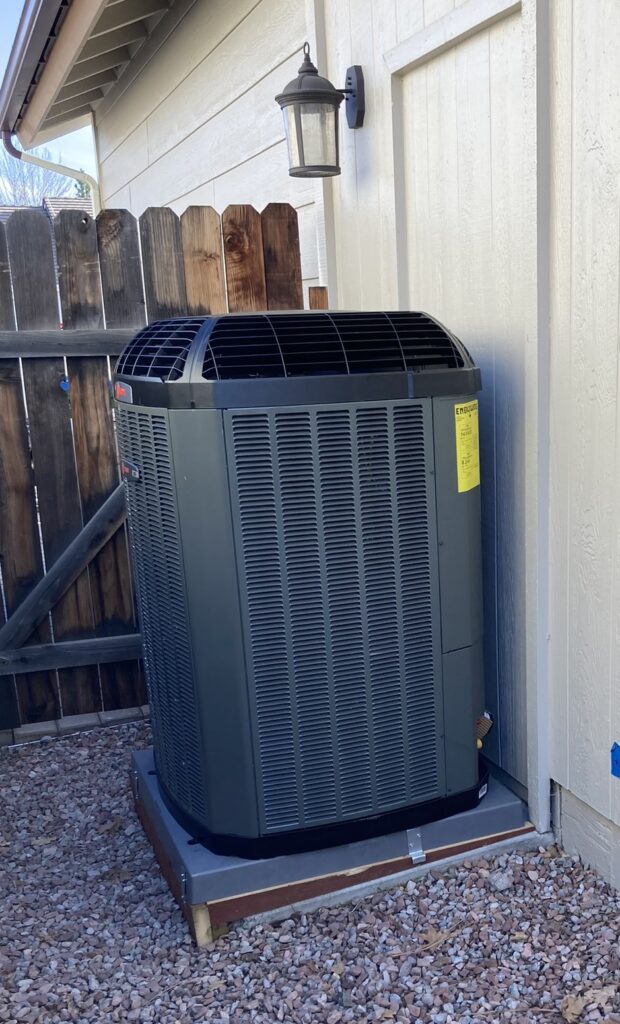
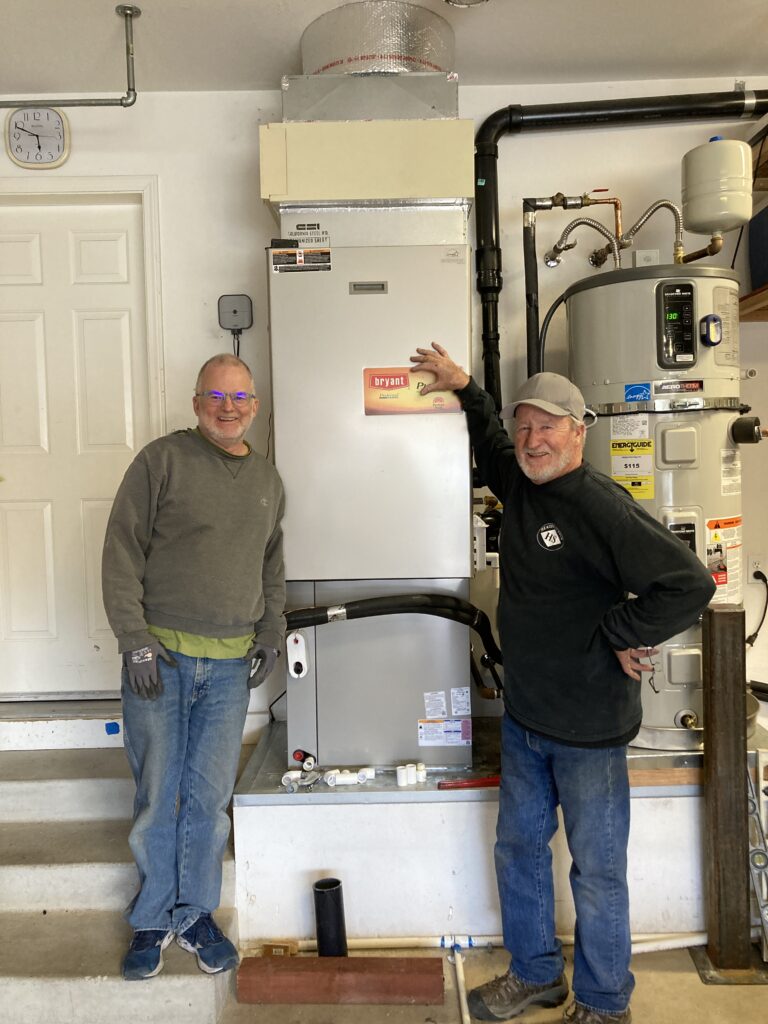
Our old A/C had been in use for 22 years and it was time to replace it. Jimmy and Scott had installed the Bryant high efficiency natural gas furnace in 2009 with the ability to support a heat pump, called a Hybrid Heat Split System. We were waiting until we had enough solar panels to power it, which happened in September 2021. Then we had to wait for the supply chain kinks to work out in order to secure a unit, which we got in winter 2022. Jimmy and Scott installed it in May and we used it for the first time in June 2022. As of this writing, we have been using the system for 8 months.
What is a Heat Pump?
A heat pump works differently than a conventional heat and A/C (HVAC) system. Instead of making hot air, it moves hot air–a brilliant idea that makes very efficient use of the electricity used to power the unit. It looks like this:
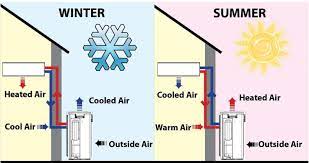
In winter a heat pump moves warm air into your home and pulls cold air out; in summer the process reverses and warm air is pulled out while cool air moves in. The basic idea is that heat is attracted to cold, so the coolant in the system collects heat and then transfers it in or out depending on the season.
Then What is a Hybrid Heat Split System?
Unless you live in a moderate climate, a heat pump isn’t enough to provide all your heating needs. In the winter, it is usually backed up by a natural gas furnace in colder climates like ours here in Reno. We have set our thermostat to use the Bryant gas furnace when temperatures outside are lower than 40 degrees F. We tried setting it to 35 initially, but found out that was a very inefficient use of electricity after we used all our banked electricity and got a $200 power bill! It turns out that the heat pump has to work very hard to extract heat at temps below 40 and it uses too much electricity, so it’s best to use the gas furnace instead. NOTE: We have a ducted system which is less efficient than a ductless (mini-split) system.
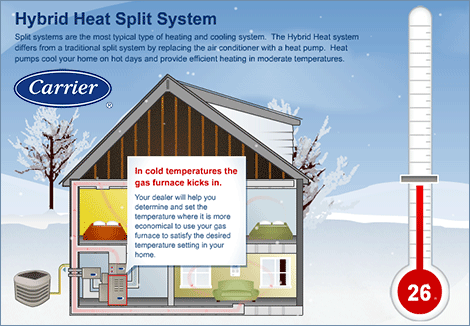
During the warmer afternoons of winter and the shoulder seasons of fall and spring, the heat pump can take over heating our home.
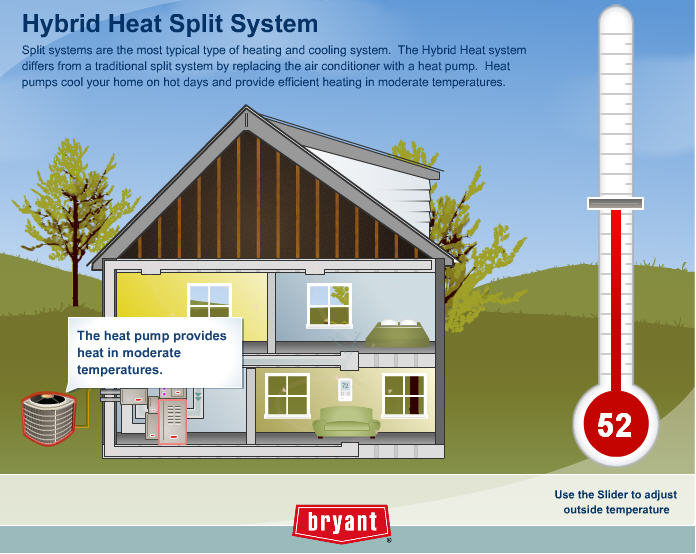
NOTE: Prior to installing the heat pump, we were using a zone heating system which included an EdenPURE infrared copper heater, a Lopi natural gas stove and a Dyson electric heater. We were only using our gas furnace to take the night chill off and when temperatures were too cold for the other systems to keep up. We have experimented with using a mix of these systems over the last 3 years-see below for how we heat our home now. Spoiler Alert: we don’t use the heat pump system very much anymore.
What It Cost
Wholesale Cost of Trane 5-ton Heat Pump $5,317
Cost to run new line set, add new coil, and change refrigerant $2,000
Honeywell Thermostat $268
Trane Tech to Check System Function $284
Total Cost $7,869
Less Federal Tax Rebate: $200
Net Cost $7,659
Compare this to the cost of replacing our old A/C with a new one:
Cost of Average New A/C $2200
Cost to run new line set, add new coil, and change refrigerant $2,000
Total Cost: $4,200
Additional Cost of the Heat Pump: $7,659 – $4,200 = $3,459
NOTE: This system was purchased at wholesale by Scott’s brother and installed by them with some additional paid assistance. This significantly reduced our costs. We would have had to run new line set, add a new coil and change the refrigerant either way.
In general, heat pump systems are used to replace oil heat, propane, or older electrical heating systems that are very expensive to operate. In these cases, they more than pay for themselves over the course of their lives. We wanted to see if our system could further reduce our use of natural gas and our carbon footprint, since we have solar panels on our roof to produce the electricity. For us, this system works in synergy with all our other systems to further reduce our use of natural gas and our carbon footprint. We will have to see if we generate enough electricity to cover the additional needs of our heat pumps, plus driving two electric cars. Stay tuned to find out! (See the Trane Heat Pump section below…)
How We Heat Our Home
NOTE: We are lucky to have good insulation and efficient double-paned windows in our home, which helps us keep the heat and cool in.
Prior to 2013, our main source of heat was the Bryant high-efficiency gas furnace. Since then we’ve been tweaking our heating system by adding zone heating.
Lopi Natural Gas Stove
In 2013, we added a Lopi Ben Franklin style gas stove (below) to our living room (also Scott’s office area). It keeps the front of our home toasty, which is really lovely for my morning practice, keeps Scott warm during the day, and makes our evenings cozy in the winter. It is very efficient and we keep it set at 69 when we are awake. During the day, this south-facing room is warmed by the sun (when it isn’t cloudy), so the Lopi gets a break. When we go to bed, we set both the main thermostat and the Lopi to 62. The front room where the Lopi is gets colder than the center of the house, so most nights it keeps the house warm enough that the main heating system doesn’t come on until 5:45 a.m. In the mornings, the Lopi helps bring the temp up so the main heating system can shut down after taking the night chill off the house. From that point on, unless it is below 15 degrees outside, the Lopi and EdenPURE (see below) take over.
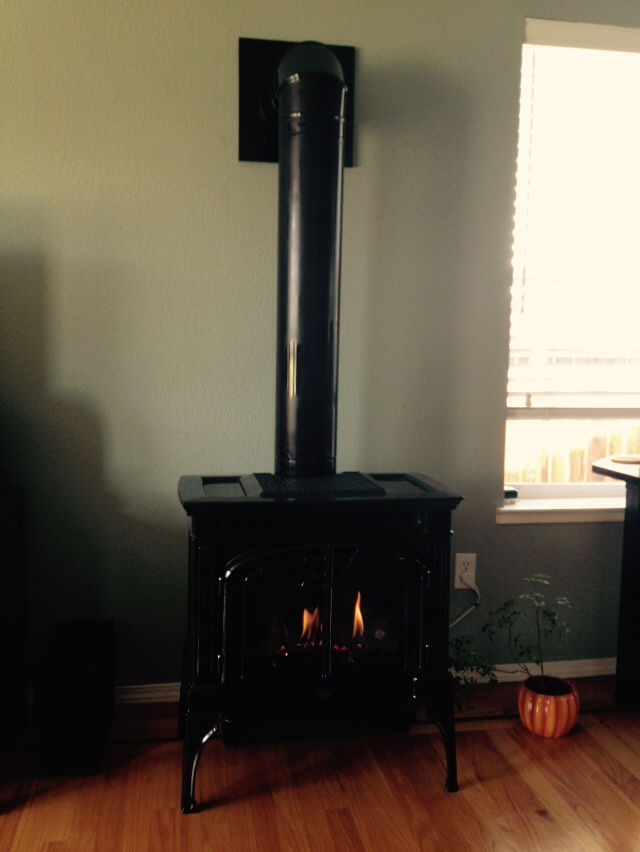
EdenPURE Infrared Copper Heater
In 2019 we added an EdenPURE infrared, copper heater to our kitchen/dining room area (which is also my office area). When the temperature is below 40 degrees outside, we use this heater. Between it and the Lopi, the front part of the house where we hang out during the day is always around 69-70 degrees. We turn off the EdenPURE when the heat pump kicks on at 40 degrees during the warmer days in winter.
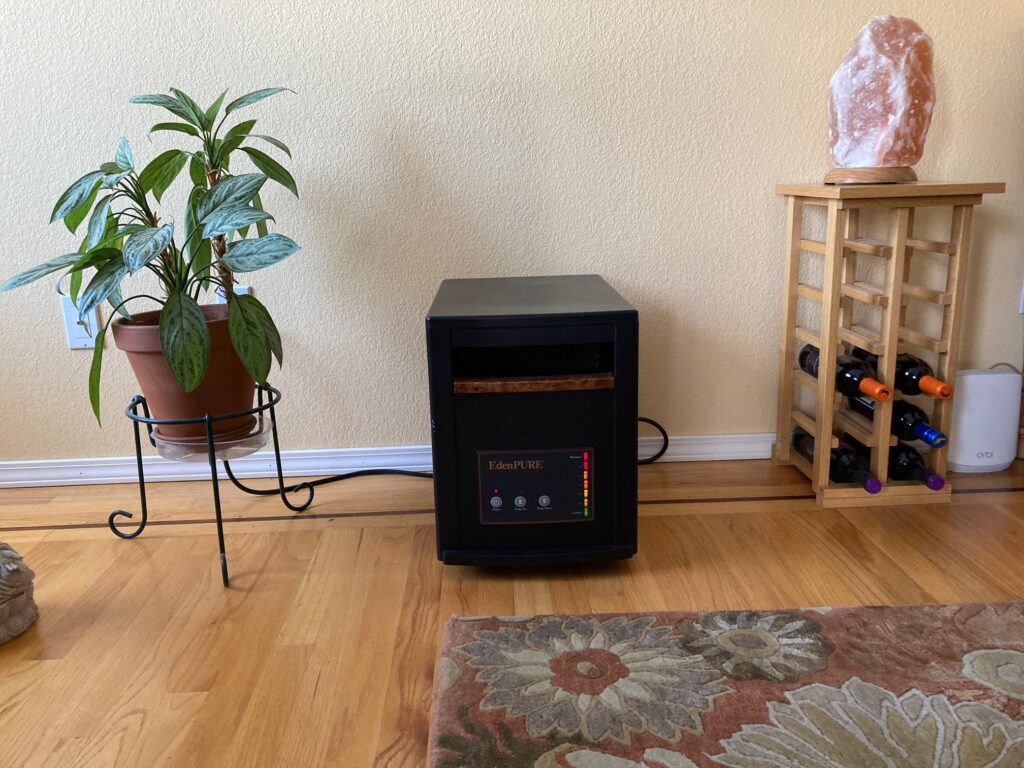
After trying this method for a couple of winters, we finally figured out that the EdenPURE runs at 1.5 kWh and the heat pump at around 3.0 kWh. The heat pump heats the whole house, while the EdenPURE and Lopi heat only the areas we occupy in the front of the house. (Interestingly, I checked and the back of the house still stays at 65-67 degrees, which is pretty comfortable.) To see what this cost us see the Trane Heat Pump section below.
Now we use the EdenPURE during the days from when we get up until sometime in the afternoon when it is often warm enough to go without heat until the sun goes down. After sunset, we use this heater while we are making and eating dinner.
Master Bedroom and Bath Systems
In our bedroom, we have a Dyson electric heater for a little extra boost while reading in bed in the mornings and evenings. (It gives us a more constant heat in winter than the mini-split, so we only use the mini-split for A/C in the summer.) We also have a heated tile floor in the master bath which keeps our master bedroom warm (and our old cat). It also helps hold warmth in the bedroom when the Dyson isn’t on.
Bryant High-Efficiency Gas Furnace
The furnace’s main function is to boost the temperature from 62-68 in the mornings. It comes on at 5:45 a.m. for about an hour before it gets warm enough for our zone heaters to take over. We turn them on when we get up around 6:00-6:30 a.m. The Bryant works the hardest from late-November-February. These are the months when we use the most natural gas to heat our home. It is also available for backup if it gets really cold (below 15 degrees). This last winter I only heard it come on twice at night, when it was below 15 degrees outside. The rest of the time our Lopi in the living room held the heat at 62+ degrees at night.
Trane Heat Pump
The Trane heat pump serves two functions: 1) it heats our home once the temp gets up to 40 degrees and above, which usually happens by afternoon in winter, except during the cold and stormy days; 2) it cools our home in the summer (see below). During the shoulder seasons of spring and fall, is when the heat pump is most efficient and is able to handle any heating or cooling needs we may have. Generally we don’t have to use much of anything from late April until about mid-June and then again from late September until about mid-October. In 2022, we used less electricity and gas from mid-September to mid-November using the heat pump, so it did it’s job. For example, in October we used 1/3 of the gas we used in 2021! (It was a very warm month, so that also contributed.) We are excited to see how the system performs this spring. Keep an eye out for a blog update this summer, after we’ve had the heat pump in place for a year.
It’s taken us 3 winter seasons to figure out how best to use our Trane heat pump. As mentioned above, we have learned a hard math lesson: the EdenPURE runs at 1.5 kWh and the heat pump at around 3.0 kWh (uses twice as much electricity). We didn’t get the heat pump because we were cold; we got it to reduce our carbon footprint.
Instead, we used about 1.5-2.0 megawatts more electricity than we needed during the cold months by using the heat pump, and we were only saving about 15 therms of natural gas! (We use about 250 therms per year now, so relatively little savings). We essentially added about 2,500 pounds of carbon to the atmosphere heating the back of the house for no good reason! OOPS!! To top it off, this increased use of electricity pushed us over what we could produce with our panels, so our power bills went up by about $300 per year.
Now we are using the Trane for heat only on mornings when the temperature is 40 degrees or above at 5:45. It takes over the Bryant furnace’s job of taking the night chill off the house and raising the indoor temperature to 68 degrees. This means it doesn’t operate very often except during the shoulder seasons when the temperatures are more mild. This is where heat pumps really shine, but unfortunately our shoulder seasons are short. We are still using the Lopi and the EdenPURE once we get up as they use less electricity.
We are disappointed that our experiment with the Trane was not what we expected. If we had it to do over, we would have replaced our old A/C unit with a newer, more efficient model and skipped the heat pump. But there is a place for heat pumps in certain settings, just not ours. See the section below on how our neighbors use their heat pumps….
How We Cool Our Home
NOTE: We are lucky to have good insulation and efficient double-paned windows in our home, which helps us keep the heat and cool in. We also have an attic fan that helps to remove heat from our attic area and keeps the house cooler in the summer.
To cool our home we use the Trane heat pump in A/C mode from about mid-June-mid-September when temperatures are in the high 80’s to over 100 degrees F. We generally keep our thermostat at 77 degrees in the summer. We used to open our windows to enjoy the cool night air, but now the ring road close to our house has become a drag strip and we can’t sleep with the windows open anymore. Truly a bummer! This summer the new heat pump A/C kept us cool and was quieter than the old system. Comparing the electricity use this summer with last summer, the new sysem uses about the same amount, which is to be expected because it uses the same technology as the old A/C to cool. Scott has decided he would like our bedroom to be cooler in the hot summer nights, so this year we will add a mini-split heat pump to our bedroom, then we can keep the thermostat for the rest of the house set to 82 degrees during the night. This should save some electricity in the summer.
We are loving our Perfect Aire mini-split that we added in June 2023! It keeps our bedroom cool on hot summer nights and also gives us the white noise we wanted to block out the drag racing. It has worked out beautifully and saves us about 500 kilowatts of electricity every summer, because we aren’t using the Trane to cool the whole house. We keep the Trane set at 82 and crack our bedroom door so the mini-split’s cool air stays in. For more information about the mini-split, see this blog: https://rhondaashurst.com/2024/03/11/our-mini-split/.
Our Neighbor’s Systems
Coming soon…
Thinking About Your Own System?
If your old A/C condenser needs replacing, a heat pump is worth considering if you have solar panels to provide the electricity and you can’t use zone heating. It can really be a win if you are using expensive heating fuels like oil or propane, or you have an old electric heat system. It can be trickier to figure out if a heat pump is best in colder climates where natural gas is available, like ours.
It’s best to get the solar panels first, since electricity is more expensive than natural gas and most of our electrical grids are powered by fossil fuels anyhow. If you live in a moderate climate where temps rarely fall below 40 degrees, you may be able to use just the heat pump. If you live in a colder climate like we do, you will need either a hybrid system like ours or you can install a ground source heat pump. With this system the heat comes from the earth, so it is more consistent and really saves electricity. If you are building a home or have some acreage, this may be the system for you. If you have a smaller home with an open floor plan, a mini-split system may be the way to go. Mini-splits are more efficient at creating heat than our ducted system and some of them with a hyper mode can create heat at temperatures well below freezing. The Inflation Reduction Act of 2022 includes tax credits to help defray the costs of adding these systems (and solar panels) to your home. We hope to be able to save 30% on the purchase and installation of our mini-split thanks to this new legislation! And we did!